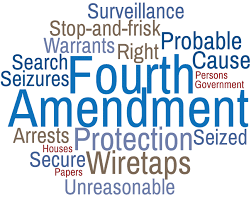“We the people…”
This week in court we will be discussing the case of Los Angeles County v. Mendez. Number four on our list of the top ten cases on the Supreme Court’s docket this year to watch, L.A. County v. Mendez revolves around the hot topic of the use of force in relation to police work, warrants, and unlawful entry into homes, businesses, etc.
This case dates back to October 2010, when two deputies from the L.A. County Sheriff’s Department responded to a call that a wanted parolee, Ronnie O’Dell, had been spotted in front of another citizen’s residence. The deputies responded to the call and proceeded to clear the house and then moved onto the backyard, under the direction of other officers. The deputies determined that O’Dell was not in any of the backyard structures; they then proceeded to another structure where two other citizens, Mendez and Garcia, we’re living. The officers failed to announce their presence as they opened the door and one deputy saw the silhouette of a person holding what appeared to be rifle and thus alerted his partner of the weapon. The two deputies proceeded to shoot both Mendez and Garcia, resulting in Mendez having his right leg amputated and Garcia being shot in the back. Throughout the trial it was unclear of whether Mendez and Garcia purposefully pointed the gun towards the officers or were merely moving it out of the way.
Mendez and Garcia sued the deputies, Conley and Pederson, claiming that their Fourth Amendment rights had been violated and that the officers had performed an “unjustified warrantless search” and did not adhere to the “knock and announce rule.” The court ruled that the officers use of force was justified, but they were held liable for the use of deadly force because the incident was classified as “intentionally or recklessly provoking a violent confrontation,” under the Fourth Amendment. At higher level courts, the decision that the officers search violated the Fourth Amendment was upheld, but they reversed the “knock and announce” violation because there is no clear declaration that officers must announce their presence again at a property they have already entered.
This case ties together many topics and questions that are currently swirling around the nation about police work. When is force necessary? How much? How justifiable is it? Can there be a clear line to define the use of force and when to announce their presence or just jump right into the situation? Are there exceptions to the declared rules? In this case, I do believe that it was fair to hold the officers liable for the shooting based on the fact that they recklessly entered a situation and failed to announce their presence again, but then again how can any of us speak on the actual events that took place; we weren’t there and didn’t have to make split life or death decisions.
Link(s):
https://www.oyez.org/cases/2016/16-369


